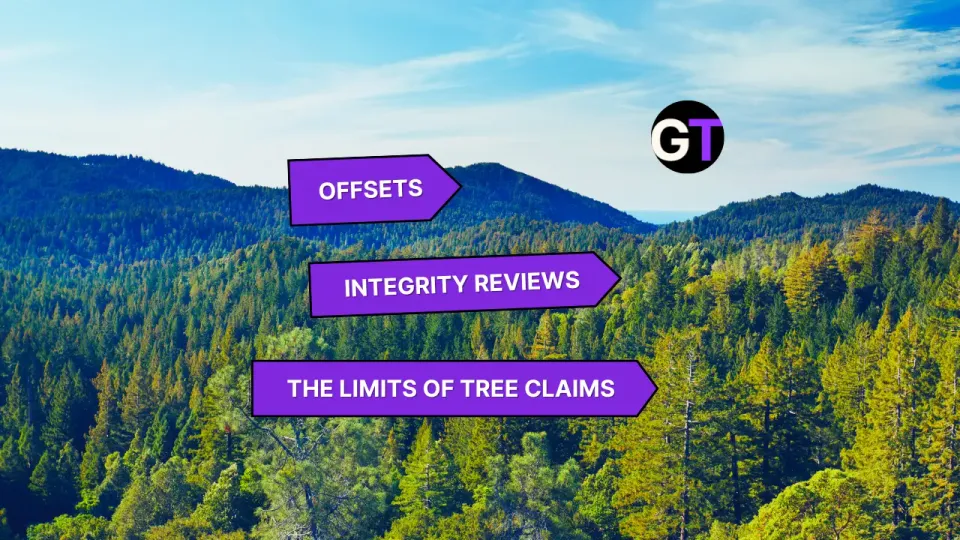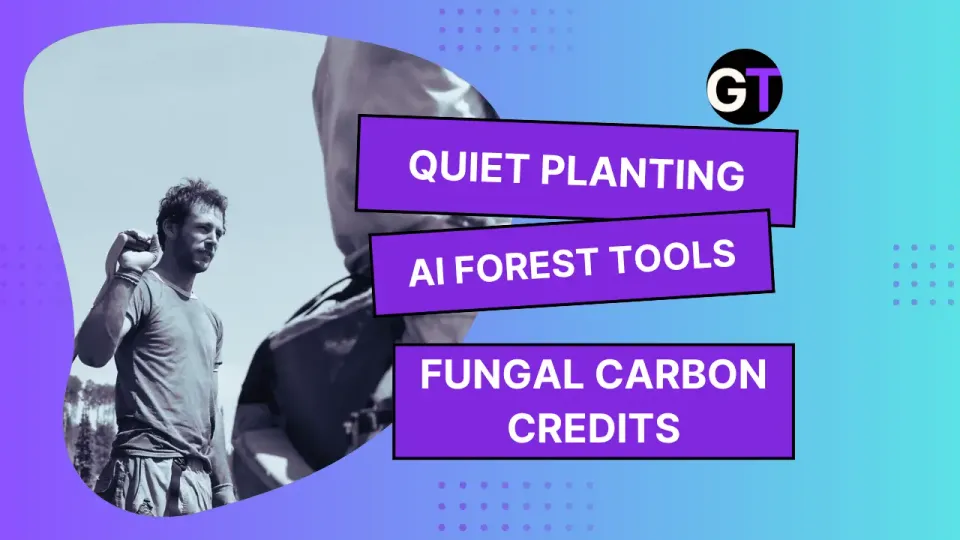Post-Fire Aspen, FAIR Data & Community Forest Wins
Weekly forest news roundup, June 27, 2025.

Sexual and Vegetative Recruitment of Aspen After a Boreal Megafire
A new study explores how trembling aspen regenerates after high-severity wildfire in Alberta’s boreal forest. Researchers found that aspen regenerated via either seedlings or suckers—but rarely both—depending on fire timing and severity. Seedlings thrived at sites that burned after spring green-up and under high surface fire severity, while sucker-dominated sites were more common when burns occurred earlier in the season at moderate-to-high severity. This distinction matters: seedling recruitment promotes genetic diversity and adaptive capacity, especially when vegetative regrowth is suppressed by severe fire. The findings offer fresh insight into post-fire dynamics and forest resilience in a warming, disturbance-prone climate.
💬 What does this mean for how we manage forests after high-severity wildfires?
👉👉 Read the full study in Fire Ecology
AI Meets Forest Monitoring: Tracking Growth for Climate Action
A new FAO–Purdue University workshop showcased how artificial intelligence can transform forest monitoring and climate mitigation. Through the AIM4Forests programme and its MATRIX model—built on the vast Global Forest Biodiversity Initiative dataset—AI is being applied to better estimate aboveground biomass growth. The event tackled core challenges like integrating AI into national GHG inventories, aligning measurement approaches, and ensuring FAIR, equitable data use. Experts emphasized the need for high-quality, inclusive data that empowers local communities and advances just forest stewardship.
💬 Could open, FAIR forest data paired with AI unlock better climate decisions?
👉👉 Read more in FAO Newsroom
Protect Young Forests for Peak Carbon Removal
A global analysis of 109,000+ plots shows that young secondary forests—those 20 to 40 years old—remove carbon up to 8x faster per hectare than new tree planting. These forests reach peak removal around age 30 and outperform new regrowth in most regions. Protecting them now could yield faster, more reliable climate benefits, especially as delays in regeneration slash future potential. Yet few carbon markets currently credit this vital strategy.
💬 If we know where peak removal is happening, why aren’t we protecting it?
👉👉 Read more in Nature
Community Forest Governance Yields Carbon, Biodiversity, and Livelihood Gains
A large-scale analysis of 314 community-managed forest commons across 15 tropical countries found that strong local governance can deliver significant co-benefits for climate, biodiversity, and livelihoods. Forests with formal local management institutions and inclusive rule-making processes showed higher carbon storage (up to 80 MgC/ha), greater tree species richness, and better livelihood outcomes, compared to those with weaker governance. The study identified five distinct clusters of forest outcomes, revealing that multifunctional success is possible but not guaranteed. Governance structures—not just ecological conditions—proved critical to achieving synergies across multiple objectives in tropical forest restoration.
💬 How can policies and finance mechanisms better support the local institutions that drive multifunctional forest success?
👉👉 Read the full study in Nature Climate Change
Nature Credits, Drone Drops & Missing Koala Dollars
From billion-dollar investor alliances to community-led forest finance, the nature credit landscape is getting crowded—with soaring promises, patchy data, and mounting pressure to prove results. This week’s roundup spans drones in New Brunswick, stalled koala park funding, Indigenous finance innovation, and the growing call for transparency across it all.
💬 As carbon and biodiversity markets scale up, how can we make sure nature finance delivers real benefits—for ecosystems, communities, and accountability?
👉👉 Read the full roundup on Ground Truth
Predicting the Black Swan: Using Extreme Value Models in Forestry
Forests face unpredictable, high-impact events—like megafires or windstorms—that are hard to model using traditional statistical methods. These “Black Swan” events, as defined by Nassim Taleb, are outliers with massive consequences. In forestry, one way to estimate their risk is through Extreme Value Analyses (EVAs), which focus on the statistical behavior of the most extreme data points—those in the far tails of a distribution. EVAs help model disturbance-driven forest mortality and estimate return levels, such as the likelihood of forest carbon loss exceeding 40 tonnes CO₂-eq every 100 years. With tools like the extRemes R package, foresters can plan for rare but impactful events—informing carbon projects, insurance modeling, and disturbance resilience strategies.
💬 Could better access to open forest disturbance and mortality datasets help scale the use of extreme value models across more regions?
👉👉 Read the full post at Arbor Analytics
NGOs Reveal Forest Destruction Caused by EU Nature Credits Pilot
A new investigation by Canopée and Fern exposes the ecological fallout of the EU's nature credits pilot project on Estonia’s Hiiumaa island. The pilot, intended to model “nature-positive” forest investment, led to the destruction of at least 27 hectares of ecologically sensitive forest—roughly 38 football fields—including old-growth habitats and areas home to protected species like the European mink. Satellite data and field visits documented clear-cutting, soil disturbance, and machinery damage, contradicting the project's claims of sustainability. NGOs argue this top-down experiment reflects poor oversight and weak definitions, undermining trust in the proposed EU nature credit market and threatening to replace real restoration funding like LIFE with unproven, market-driven models.
💬 Could transparent, open-source monitoring systems prevent “nature-positive” projects from causing actual ecological harm?
👉👉 Read the full investigation from Fern
A Global Assessment of Plant and Animal Community Responses to Forest Management Over Time
A major global review of over 300,000 biodiversity observations across 182 studies reveals that forest management practices strongly shape biodiversity outcomes. Selective cutting and agroforestry were found to support more intact and threatened biodiversity than intensive systems like tree plantations. While animal community similarity and intactness improved over decades in some managed forests, species richness and abundance did not recover at the same rate—suggesting partial recovery rather than full ecological restoration. Longer rotation periods and lower-intensity practices were linked to better outcomes for species adapted to undisturbed forests.
💬 How can open biodiversity data help track long-term changes in species composition across different forest management systems?
👉👉 Read the full study in Global Change Biology
Rewilding and Agriculture to Tackle Biodiversity Crisis
A new study offers a practical blueprint for integrating rewilding into agricultural landscapes—suggesting that setting aside 20% of farmland for nature and adding wildlife-friendly measures to another 10% could halt biodiversity loss while preserving food production. The authors propose linking rewilded “core conservation areas” with green corridors and embedding lower-impact farming practices on remaining land. The approach could improve ecosystem services like pollination, soil health, and water retention—especially in intensive, degraded farm regions. Incentives like payments for ecosystem services may boost farmer participation and landscape-scale impact.
💬 What kinds of open land-use and biodiversity data would help track progress toward this 30% restoration goal?
👉👉 Read the full study in Frontiers in Ecology and the Environment
Can Nature-Based Credits Truly Deliver on Permanence?
A new discussion paper from Nature Base evaluates whether carbon credits from land-use projects—like reforestation and peatland restoration—can credibly support net-zero claims. It finds that current practices fall short: courts in Germany and the U.S. have ruled that short-lived credits (typically valid for 20–100 years) cannot offset CO₂ emissions that last for centuries. The paper proposes a credit-for-credit permanence guarantee, which pairs temporary credits with permanent ones (like biochar or direct air capture) to uphold the legal integrity of carbon claims even after project reversals. While buffer pools and insurance offer some safeguards, they don't extend beyond project lifetimes. A guarantee mechanism could future-proof nature-based solutions, especially as demand for high-integrity credits grows.
💬 Could transparent open data on credit duration, risk, and replacement mechanisms help regulators and buyers spot credible climate claims?
👉👉 Read more at Nature Base
Fungi After Fire: How Megafires Reshape Soil Life
A new study tracks how soil fungal communities responded to a historic 2022 megafire in the Sierra de la Culebra, Spain. Researchers compared burned and unburned plots six months after the fire and found major shifts: symbiotic fungi (like ectomycorrhizae) sharply declined, while opportunistic and saprotrophic fungi surged. This early ecological transition suggests that intense wildfires can destabilize underground ecosystems long before forests visually recover—impacting nutrient cycling, tree regeneration, and ecosystem restoration strategies.
💬 Could more open post-fire soil data help guide smarter restoration in a warming world?
👉👉 Read more in FEMS Microbiology Ecology via Oxford Academic
Global Soil Data at 30m: Open Access, AI-Mapped & Ready to Use
After years of preparation, the OpenLandMap-soildb project has released a global 30m-resolution soil dataset, covering key variables like soil carbon density, pH, texture, and USDA soil subgroups. Soil carbon and pH are dynamic, mapped in 5-year intervals, while texture and bulk density remain static. The dataset reveals how urbanization and degradation reduce soil organic carbon, and it offers open, CC-BY licensed access via cloud-optimized GeoTIFFs and Google Earth Engine. With a strong commitment to FAIR data principles, the team invites contributors and developers to join the effort toward better global soil monitoring.
💬 Could truly open, high-resolution soil data reshape how we track land degradation and carbon stocks?
👉👉 Read more on Github
5 Million Trees in One Hour?
Burkina Faso marked its seventh National Tree Day with a bold goal: planting 5 million trees in just one hour. Inspired by Thomas Sankara’s legacy, the event united citizens, ministries, and international partners in the largest anti-desertification campaign in the country’s history. The 2025 theme spotlighted medicinal plants as a dual force for health and climate resilience. The government aims to plant 20 million trees this year and create medicinal plant nurseries in every province—each at least 2 hectares in size.
💬 A powerful mobilization—but where’s the follow-up data? Are maps, species lists, or survival rates available for public review?
👉👉 Read more in People’s Dispatch
Can Pistachio Trees Rebuild a Region?
In Syria’s northeast, where Islamic State once held power, reforestation and biodiversity projects are offering a lifeline. Women in al-Sheddadeh are planting pistachio seedlings through The Green Tress NGO, while Raqqa's local authorities and private nurseries aim to restore native species and environmental awareness. The projects hope to reverse desertification, provide economic alternatives to extremism, and reclaim land degraded by war and monoculture.
💬 Inspiring initiatives—but where’s the data? Are survival rates, species inventories, or pollution metrics publicly accessible?
👉👉 Read more in The New Arab
Reforestation Pays Off in the US South-Central
A new study by Resources for the Future and the USDA Forest Service shows that U.S. timber supply is largely price inelastic—with the exception of the Pacific Northwest—but South-Central forests stand out for profitable, sustainable reforestation. Plot-level data from 115,643 FIA sites show that private landowners respond to sawtimber price increases by planting more trees, with long-term growth in South-Central forests yielding well above breakeven. The study finds no imminent timber scarcity, suggesting current practices can meet future demand.
💬 If profit drives reforestation, what policies could unlock similar gains in regions lagging behind?
👉👉 Read more on Lesprom
Ilocos Tree Planting Boasts 85% Survival—But Where’s the Data
In 2024, over 550,000 seedlings were planted across the Ilocos Region under the Philippines’ National Greening Program, with officials reporting an impressive 85% survival rate. The effort spanned 320+ hectares and focused on indigenous species like narra and acacia. But while the numbers sound good, officials offered little detail on how survival was verified or what follow-up monitoring looks like across the 34 regional watersheds. Amid growing scrutiny of global reforestation claims, even good news begs documentation.
💬 “85% survival” sounds great—but can we see the receipts?
👉👉 Read the full article at PNA
FAO Launches Global Forestry Recognition for Its 80th Anniversary
To mark 80 years of work on food security and sustainable development, the Food and Agriculture Organization of the UN is calling for nominations to honor institutions and initiatives that have shaped global forestry. The recognition spans ten thematic areas—from afforestation and restoration to forest finance, climate mitigation, and technological innovation. Eligible nominees include governments, NGOs, academic institutions, and private actors with major contributions to forest policy, management, and equity across decades.
💬 Who deserves global recognition for transforming forestry—and how can these honors uplift the often-unseen stewards of the world’s forests?
👉👉 Read more from the FAO

Edited by Chris Harris

This work is licensed under a
Creative Commons Attribution 4.0 International License.





